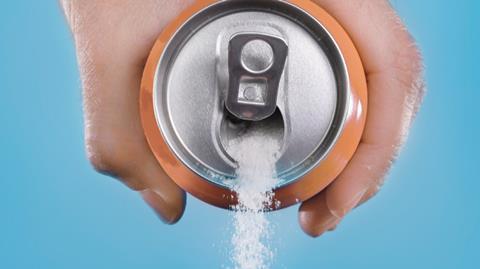Most categories haven’t got anywhere near the targets set for them. Will a new deadline – or a new government – make any difference?
If the failure of the government’s sugar reduction programme illustrated a need for a new approach to tackling obesity, the results of its calorie reduction equivalent last week rammed home the message.
But while the government quietly drew a line under the sugar reduction programme’s missed goals in 2022, the Office for Health Improvement & Disparities (OHID) has given the industry an extra year to hit calorie targets, despite finding the vast majority of categories have failed to get anywhere near them in six.
So is the new deadline of the end of 2025 anything more than kicking the can down the road to the next government? And does anyone in the industry and government actually care about the strategy any more?
It was in March 2018 that Public Heath England, OHID’s predecessor, first announced tens of thousands of supermarket SKUs would have to shrink or be reformulated to reduce calories, hot on the heels on the launch of its sugar reduction programme the previous year.
Both were part of the obesity strategy launched under PM Theresa May, which also included the 2018 introduction of the soft drinks sugar levy.
That both programmes have fallen disastrously short will not have surprised food industry bosses, who from the start claimed the moves were destined to fail.
In December 2022, the government snuck out a report, more than a year late, revealing that far from cutting sugar across confectionery, sweets and chocolate bars by 20% as planned, there had been an increase in sugar sold by retailers and food manufacturers of more than 50,000 tonnes.
Last week, OHID echoed the stealth approach to bad news with a similar, understated report revealing the calorie reduction programme had achieved “limited progress”. Many sectors, including family meals and the out-of-home sector, instead showed big increases in calories.
The target had already been scaled back in 2020, from a 20% reduction to 10% for many categories.

Slim pickings
But based chiefly on Kantar data covering 2021, the report found the biggest decrease in the sales-weighted average total calorie content per 100g of any product was for garlic cheesy bread. And it was only 2.4%.
All other products saw changes of 2.0% or less, with family meals, such as a beef casserole, curry without rice or a fish dish seeing calories increase by more than 10% compared with 2017.
The out-of-home sector also saw sweeping increases in the number of calories per serving in main meals, starters, side dishes and sandwiches, the report showed.
The FDF was among organisations that strongly campaigned against PHE’s targets, outraged at the introduction of the programme during the pandemic. The report now acknowledges the “pressures” on the industry caused by the pandemic, including an increase in overall sales and therefore calories driven by the closure of the hospitality sector in lockdowns.
The findings do not reflect a report by the FDF last year, also compiled by Kantar, which showed FDF members contributed 13% fewer calories, 15% fewer sugars and 24% less salt to the average shopping basket than eight years prior, albeit with contrasting performances from companies such as Coca-Cola, Kellogg’s and Unilever, and the thousands of SMEs who had been failing to keep up.
“It’s hard to see the changes in the data we might expect from this work, as the report published today covers the Covid-19 pandemic, where we know there were big changes to people’s shopping habits – with limited access to eating out, and workplaces and schools being closed,” says an FDF spokeswoman.
Read more:
-
Henry Dimbleby calls for total ad ban on UPF and HFSS food
-
Report ‘names and shames’ companies for reliance on food sales harming kids
-
Health lobby backs government plans for food industry HFSS reporting

Another industry source puts it more bluntly: “The report sadly rams home the problems that were raised with this sort of reporting when it was proposed.
“The figures are out of date and not an accurate reflection of the industry’s work in reducing calories. We never signed up to this approach and I’m not sure it’s front of mind for ministers either.”
However, Obesity Health Alliance director Katharine Jenner says she is shocked at the ease with which the government and industry seem able to sweep the findings aside.
“We always knew there would be pushback but questions have now got to be asked about what happens next and whether the government follows up with its promises to explore other measures if these targets weren’t met.
“I also don’t understand why we have to wait another year. Instead of putting this back until 2025, why can’t we have six-monthly reports? If the industry are so worried that this is old data, then why can’t we see up-to-date figures?”
The release of the report, low-key or not, comes at a crucial time for the future of public health policy, including this week’s launch of an appeal for evidence in an inquiry into obesity by the House of Lords.
Meanwhile, the DHSC has been drawing up plans for a new system of health reporting by all major food companies, which would see them produce regular updates on their proportion of sales from HFSS products, among other metrics.

Mandatory targets
While the current government is determined these remain voluntary, health campaigners hope to persuade a new Labour government to mandate them.
Either way, PHE’s legacy of targets now looks doomed, not least because of the drain in the OHID’s resources.
A recent report in the Health Service Journal claimed the OHID had been “effectively dismantled” by the government thanks to a sweeping restructure involving the loss of senior and experienced management.
Sources told the publication OHID’s teams had been “significantly cut”, in some cases by 50%.
While the industry shed few tears over the end of what the Institute of Economic Affairs called the “bossy, puritanical and illiberal” era of PHE, the body set up by Matt Hancock to replace it has hardly lived up to its billing as a “new era” for public health.
The DHSC claims tackling health inequalities and taking preventative measures remains “vital” and that the role of OHID is still “crucial”.
But the reality seems to be that in the space of three years it has gone from a new vehicle headed by chief medical officer and key pandemic figure Professor Chris Whitty, to what appears to be a shell organisation, with little influence over industry or ministers.

























No comments yet